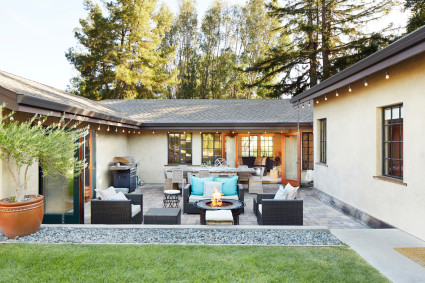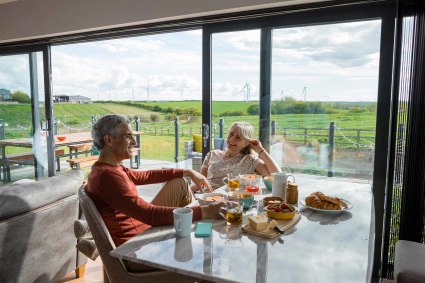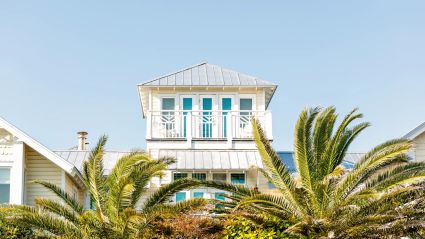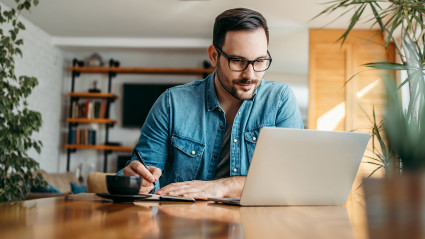Buying
Get tailored advice for confidently buying your dream primary or second home — and how Pacaso can help take everything off your plate.

Common pitfalls of DIY second home co-ownership
Shared ownership of real estate isn’t a new concept. In some cases, second home co-ownership happens through inheritance, when beneficiaries agree to share a family vacation home. Other times, it’s intentional — friends or relatives may pool their resources to purchase a second home as a more affordable alternative to buying one outright. In either case, owning a second home thorough DIY co-ownership often comes with hidden real estate challenges. Families change, friendships wane, people move, and priorities shift — all of which can add stress to home management and decision-making. Disagreements over schedules, costs, or even decor can escalate over time, straining both finances and relationships. Before you buy together, it’s important to understand what can go wrong. Many DIY co-owners make the mistake of putting multiple names directly on the property deed. While this can seem like the simplest way to share ownership, it can actually create personal liability. If a dispute arises or one co-owner defaults on payments, everyone’s personal assets may be at risk. Creating a clear LLC co-ownership operating agreement can help separate ownership from individuals, but creating and managing that structure correctly takes time, legal coordination, and ongoing oversight — responsibilities that can easily become burdensome for casual co-owners. Most informal co-ownership arrangements begin with good intentions but lack a formal operating agreement. Without one, there’s no clear roadmap for decision-making or conflict resolution. Co-owners may disagree about home management, maintenance costs, decor choices, or guest use, and those gray areas can quickly strain relationships. An operating agreement for second home co-ownership should spell out everything from who pays for what, to how the home can be used, to what happens if someone wants to sell their share. Without these guidelines, misunderstandings and tension are almost inevitable, especially when personal relationships overlap with shared financial commitments. Even the best relationships evolve over time. Divorce, job changes, or relocations can leave one co-owner wanting out. Without formal exit procedures, selling or transferring a share can become complicated and lead to other real estate challenges. When you enter a second home co-ownership agreement, you’re likely choosing people you trust and feel aligned with financially. But circumstances change. A once-stable co-owner may face unexpected challenges or simply lose interest in maintaining a shared property. Without a structured plan for how to handle those changes, an informal arrangement can quickly become a financial or legal headache. Sometimes second home co-ownership isn’t planned at all — it happens through inheritance. When multiple family members inherit a property together and take no formal action, they typically end up in an ownership structure called a tenancy in common. This means each heir has equal rights to use the property, regardless of their financial contribution. Without clear agreements in place, disputes can arise over who gets to stay when, how expenses are shared, or what happens if one person wants to sell. These disagreements can strain family relationships and, in some cases, lead to costly legal proceedings. Owning a second home with others might seem simple at first, but home management can quickly become a full-time job. DIY co-ownership means coordinating everything yourself — from cleaning and repairs to bills, vendors, and scheduling. When multiple owners are involved, even routine decisions can become complicated. Without a neutral party overseeing operations, disagreements may arise about which vendors to hire, how to split expenses, or who’s responsible when something goes wrong. Over time, these small frustrations can snowball into major conflicts, turning what was meant to be a relaxing getaway into a source of stress. Forming an LLC co-ownership structure on your own can help reduce some of the legal, financial, and emotional risks of second home co-ownership, but managing it yourself still takes time, coordination, and expertise. From finding trustworthy co-owners to setting up the LLC and handling ongoing home management, DIY arrangements can quickly become overwhelming. That’s where Pacaso comes in. We bring together qualified buyers, handle every aspect of the sale and LLC formation, and professionally manage the home so you don’t have to. Owners enjoy equitable scheduling, transparent finances, and a seamless experience backed by Pacaso’s expert team. With Pacaso, you focus on what truly matters — browsing picture-perfect listings, choosing a home you love, and enjoying every stay. We make second home co-ownership simple, secure, and turnkey.
Read
Free home down payment calculator
Dreaming of expanding your real estate portfolio by adding a We crunch the numbers to estimate how much home you can afford and how much cash you’ll need, calculate the down payment and share helpful tips to explain what a down payment is and help you discover your ideal down payment. How to use the down payment calculator To use our house down payment calculator, you’ll need to pull together some financial data, enter it into the calculator and review your results. Here’s how to use the down payment calculator. Step 1: Gather home data Assemble the financial information relevant to the home you want to purchase. Here’s what you need: Step 2: Enter your data into the calculator Next, you’ll enter your data into the house payment calculator. Double-check that you’ve inserted your information correctly since these inputs will affect your results. When you are ready to review your results, click “Calculate.” Step 3: Review your results Once the calculations are complete, it’s time to see how much down payment you can afford for this home price. Now that you know how to calculate down payment estimations with our calculator, let’s explore the manual way to calculate down payments. How do I estimate a down payment manually? Here’s a step-by-step walkthrough of using a down payment estimator to help you determine if you can You can use this process to calculate how much a down payment is on a house. How much should I put down on a house? You’ve likely heard that a standard down payment is 20% of the total home price, but that isn’t always the case. While a 20% down payment allows you to avoid paying Private Mortgage Insurance (PMI), there are other options available depending on the type of loan you select. While a smaller down payment can help you get into a new house faster, you’re likely to have higher monthly payments and accrue more interest over time. Putting more money down up front can reduce your total loan balance and interest, more quickly eliminate (or avoid) PMI and start building equity. A mortgage down payment calculator can help you find the best option for your situation. What to look at when calculating a second home down payment When A down payment calculator can help you quickly understand if your ideal home is within reach or if you need to make financial adjustments to prepare for your next home purchase. Make financing a second home attainable If you want to Plus, Pacaso handles the details so you can focus on enjoying your home. Scheduling is easy and equitable, and each Pacaso home is taken care of by a dedicated property manager, giving you a hassle-free and turnkey experience throughout the year.
Read
5 steps for buying a vacation rental
Buying a vacation rental can make adventure (or relaxation, depending on how you like to vacation) a regular part of your life. Not only do you end up with a place that’s easily available for a getaway, but you can also bring in passive income by renting it to others. However, buying a vacation rental isn’t all fun in the sun — it can be a major commitment both financially and time-wise. Before you make a vacation home investment, it’s crucial to understand the process and options. In this guide, we walk through five steps to investing in vacation rentals. We also share why co-ownership with Pacaso is an even better option. 1. Choose the right location To hone in on the right location, research tourism demand. Consider whether the area is a popular You should also understand the Finally, get clear about how often you hope to use the space yourself. Think about whether you hope to visit frequently or if you’re more likely to keep it rented out for passive income. This is an important consideration — not just logistically but also because of tax and financial implications. 2. Run the numbers Prior to buying a vacation property, crunch the numbers to understand whether you can Vacation rental income When it comes to what you’ll bring in, consider the possible return on your investment, including: Be conservative in your projections. Remember that income from a vacation rental can fluctuate by season, and the success of your rental depends on factors such as competition, marketing and reviews. Vacation rental expenses Next, think about the potential expenses of owning a vacation rental. These may include: 3. Secure financing Financing a vacation rental can be more complicated than purchasing a primary home. Prepare for a And just like with any home purchase, plan for additional costs, including: 4. Understand legal and tax requirements Look into the unique legal and tax requirements of the local area. Some locales require operating permits or occupancy taxes, and in most cases, you’ll be on the hook for different tax rates for an investment property than for a primary residence. It’s crucial to have proper insurance coverage, too, so ensure your policy covers short-term rentals. Many homeowners insurance policies don’t include this as a matter of course, so do your due diligence. And finally, if your property is part of an HOA, you should understand the bylaws and rules to make sure you’re permitted to rent out the unit. If your prospective vacation rental is outside the country, be sure to look into laws and taxes for international buyers before making a commitment. 5. Manage the property After you’ve selected a property and made the purchase, decide how you’ll manage it. You might choose to manage it on your own, which can be time-consuming: you’ll be responsible for all communication with guests, booking, marketing and maintenance. Another option is to hire a property management company, which can be more expensive but simplifies the process and takes the work off your hands. Keep track of your income, expenses and taxes to ensure you’re compliant with regulations. You may also want to consider additional vacation rental insurance that helps protect against liability issues or damage from guests. Buying a vacation rental vs. co-owning with Pacaso Buying a vacation rental can be rewarding, but it also brings risk, including financial and logistical challenges as well as quite a bit of work to keep everything running. This can quickly turn your relaxing haven into a demanding second job. Pacaso offers a way to own a With Pacaso’s co-ownership model, you pay a fraction of the cost and share expenses with fellow co-owners, giving you a beautifully designed and furnished home with dedicated support: Pacaso provides a team to help before, during and after your stay. You’re able to book a stay simply via the Pacaso owner app, and many co-owners visit their vacation homes six to seven times a year. But if you someday decide to move on, you can sell your shares. Historically, shares have sold for an average 10% gain, so you can come out ahead. Simplify your vacation home dreams with Pacaso Buying a vacation rental sounds appealing, but the downsides might make you think twice. If you’re still dreaming of a way to buy vacation rental property, consider Pacaso. Pacaso offers turnkey luxury at an affordable, shared cost — we even Ready to find your dream vacation home? Check out our
Read
The essential 2025 vacation home maintenance checklist
Now that you own a vacation home, it’s time to learn how to properly care for your asset. Our vacation home maintenance checklist includes the weekly, monthly, quarterly and annual tasks that will keep your home in pristine condition, as well as a remote maintenance checklist so you can manage things from afar. Knowing how to maintain a vacation home means staying ahead of major shifts in temperature, weather patterns and potential repairs. We’ll cover seasonal to-do’s you should know, plus helpful tips to consider while using our vacation house checklist. If second home care isn’t something you have the bandwidth to tackle on your own, consider becoming a The ultimate vacation home checklist for routine maintenance With the help of our vacation home maintenance checklist, you’ll be able to stay on top of your home’s essential tasks year-round. To use the checklist: Whether your Below, we’ll cover what maintenance tasks you need to complete in each time frame. Weekly vacation home maintenance Performing these maintenance tasks every week can help keep your vacation home in great shape. If you’re unable to tend your vacation home weekly, consider hiring a Monthly second home care Some vacation home maintenance responsibilities don’t require your weekly attention. Complete these tasks every month to keep your vacation home running smoothly: Seasonal home maintenance checklist No matter what Yearly vacation home maintenance checklist At the beginning or end of every year, it’s important to assess any damage your vacation home may have endured. While you’re at it, complete the following maintenance tasks to prevent further wear and tear: Absentee maintenance checklist If you Remote maintenance checklist Even when you’re miles away, staying connected to your property helps keep everything running smoothly year-round. From smart technology to professional services, here are simple ways to maintain your home remotely and keep it in top condition. Second home property management Between seasonal upkeep and annual inspections, managing your property can quickly become overwhelming. That’s where a trusted partner like Pacaso makes all the difference. With Pacaso, you enjoy the benefits of second home ownership without all the hassles. Explore what co-ownership of a fully managed vacation home can offer you and your family. Each Pacaso home is equipped with a dedicated Does managing a second home seem overwhelming? Explore what co-ownership of a fully managed vacation home through Pacaso can offer you and your family. Each Pacaso is equipped with a dedicated property manager, allowing you to prioritize the enjoyment of
Read
Timeshare alternatives: 9 better options you must know
There are far better vacation options, including: Let’s explore each alternative and explain how it differs from the typical reasons not to
1. Second home co-ownership Second home co-ownership is when a property is jointly owned by multiple people. Buying a vacation home is a greater upfront expense than a timeshare, but you don’t have to be the sole owner. With this timeshare and Whether you’re buying with a group of friends or buying a Pacaso second home, you still have true real estate property ownership. You’re not just buying the right to use a hotel or condo-sized space for a set period. Timeshares are notoriously difficult to sell due to the many rules and limitations owners must abide by. The timeshare is also one of many identical units, creating an imbalance between supply and demand. On the other hand, unique homes attract buyers who must compete against each other in the whole housing market. Browse a plethora of luxury co-ownership options all over the world with Pacaso’s 2. Vacation rentals Vacation rentals are furnished spaces that are rented out on a short-term basis. Airbnb is as popular as ever, with 265 million users and over 7.7 million listings, according to Lighthouse. People choose vacation rentals because renting a property from a private owner is often cheaper than comparable hotel rooms, and they often give travelers added perks like kitchens and convenient locations. However, vacation rentals can come with charges like cleaning fees, sometimes making them even more expensive than hotels. Vacation rentals are considered preferable alternatives to timeshares because they give greater flexibility in where and when you can vacation. You’re only paying for specific days, so you aren’t on the hook for yearly fees on top of the purchase price of a timeshare. Timeshare owners often sell their timeshare days when they can’t use them, giving vacationers the option to visit the same timeshare facility without the long-term commitment. 3. Hotels Although Hotels often provide discounts to certain groups (like the military and AAA) or offer discounted rates throughout the year, making them even more affordable. Some hotel chains offer rewards programs, so the more you stay there, the more you get back. 4. Hostels A hostel is a budget-friendly alternative to hotels with dormitory-style rooms and communal areas. They’re ideal for backpackers and young travelers seeking a social vacation where they might meet people from all walks of life. Hostels are typically sparse in accommodations compared to timeshares, but the trade-off is worth it for people who enjoy different locations every year. You can find various types of hostels on apps and sites like Booking.com. In a budget hostel, you may stay in a room with six or more people. A boutique or luxury hostel may offer more upscale vibes and cleaner amenities, while party hostels host social activities and late active hours. 5. Resorts Resorts offer an all-inclusive appeal of many of the best timeshares, such as private beach access, live entertainment, gourmet food and guided tours. You’ll spend less time planning all the details of your vacation, leading to less stress and more time enjoying your break. Just like hotels, resorts give you the flexibility to stay for longer or shorter durations than a timeshare. You won’t be boxed into traveling at predetermined times of year, and you can visit whenever you want. One example of a famous luxury resort is the Four Seasons Resort Hualalai in Hawaii, which boasts many amenities like spas, pools, beach access, multiple restaurants and exceptional customer service. 6. Travel clubs Travel clubs offer group travel rates to various destinations. Travel clubs operate similarly to timeshares and vacation clubs, while being slightly more affordable. Travel clubs require yearly membership fees, and some clubs also charge maintenance fees. These combined costs are often lower than those of vacation clubs. The benefit of travel clubs is that they arrange for group rates, making your stay cheaper while giving you the benefit of travel companions. Oftentimes, the club is centered around a shared trait, like a hobby or age group. Aside from the social aspect of travel groups, travel clubs also free you from long-term commitments. Even the cost of an inexpensive timeshare begins to add up over the years if you aren’t able to sell it. Since membership in a travel club is yearly, you’ll only lose what you’ve already spent. 7. Vacation home ownership One big draw of owning a timeshare is the dependability of returning to the same destination year after year while avoiding the rising costs of accommodations. Buying a second home in a vacation destination gives you those same benefits and more. Unlike a timeshare, buying a vacation home gives you real equity in the property, so you have the potential to recoup the money you put into it over the years. Timeshares rarely appreciate in value, and due to the many When you have your own vacation home, you have the freedom to use it as much as you want. In contrast, most timeshare options only allow you to use them once per year and have fixed scheduling limitations. 8. Vacation clubs Vacation clubs are travel services that offer members access to different vacation locations and amenities within their network of affiliated properties. For example, a Holiday Inn Club membership works by purchasing credits. However, many clubs have blackout dates that restrict your ability to travel unless you pay more money. Depending on the club you join, it could cost more per year than even luxury timeshares, but you’ll have easier access to multiple destinations. 9. Fractional ownership Fractional ownership is a collaborative investment where multiple parties share ownership of a vacation property. Each investor maintains specific ownership rights and entitlements to the asset based on their contribution. Fractional ownership is similar to vacation home co-ownership in that you can schedule specific usage times and/or access to different parts of the property. Splitting the costs of a vacation home comes with benefits like owning a home in a luxury location that you might not otherwise be able to afford. You also share upkeep and maintenance costs. However, it also means all major decisions must go through all ownership partners. You’re also splitting benefits, leading to potential disagreements between owners. How to resell your timeshare? As you browse timeshare exit vacation alternatives, you may wonder how to best get out of a timeshare. Though it can be difficult, there are a few ways to resell your timeshare. Here are some options: Consider second home co-ownership These timeshare alternatives may help you avoid a major scam and stick to your original goal of enjoying a beautiful vacation with your loved ones. Unlike a timeshare,
Read
Financing a second home may be easier than you think
Owning a second home is more attainable than ever, thanks to a variety of financing options, moderate interest rates and the new model of LLC co-ownership. But before you take the leap, it's important to know what you're getting into when it comes to financing a second home. From budgeting for the unexpected to differences between loan requirements, doing your research helps you make the right financing decisions so you can enjoy your second home with no regrets. What are the hidden expenses in a second home? When shopping for your ideal second home, it can be tempting to focus only on a property's list price and monthly mortgage payments. However, owning a second home comes with other financial responsibilities. Crunch those numbers, too, before you look into financing. Budget for: What's different about Pacaso's LLC co-ownership model With What do I need to know about financing a second home? If you own your primary residence, you're probably familiar with the process of financing a home. While many of the steps are the same, there are a few important things that are different when getting a home mortgage on a second home. Here's what you need to know. Financing options for second homes The good news is there are multiple ways to pay for a second home, including combining more than one strategy, including these: How is taking out a mortgage on a second home different? Once you've calculated the costs and you know how much you're ready to spend for your second home, it's time to think about financing. Your first thought might be a traditional mortgage — after all, that's probably how you financed your first home. However, while a mortgage for a second home has all the same elements as a traditional first mortgage — a down payment, credit score checks, debt to income ratio calculations — the qualification criteria isn't quite the same when it comes to financing a second home. Here are a few things to know about financing your second home with a mortgage: How long it takes to get a second home mortgage Once you've found the Differences between a second home and an investment property People often use the phrases "second home" and "investment property" interchangeably, but practically speaking, they're To qualify as a second home, it must be used by you at least 14 days each year. And, you can't earn rental income on it more than 180 days of the year. The home also must be Alternatively, an investment property is occupied by you fewer than 14 days each year. It may generate short-term or long-term rental income, and it can be within 50 miles of your primary residence. These distinctions can make a big difference in affording a second home. A home mortgage for an investment property often requires a higher down payment, better debt to income ratio and a higher interest rate than a second home, as it's seen as a riskier investment. Pacaso's integrated financing options In addition to the cash and credit options discussed above, Pacaso works with partner banks to offer competitive-rate
Read
What is an empty nester? A guide to life after kids leave home
What is empty nest syndrome? Empty nest syndrome occurs when parents report the feelings of grief, a loss of purpose, and loneliness after their children move out. While empty nest syndrome isn’t classified as an official health condition, it’s well documented — and very common. It may take some time for parents to adjust to the new normal of no children in the home. For most people, these feelings pass over time as they learn to navigate their new lifestyle. While entering the empty nest phase of life represents the closing of one chapter, it also ushers in the beginning of another — one with more time to focus on other parts of life, like relationships with partners and friends, hobbies and travel. It also offers an opportunity to get to know grown children as adults, which can be a very rewarding experience in itself. What are the symptoms of empty nest syndrome? While the experience is different for every parent, it’s common to have a variety of emotions during this time: What is the average age of empty nesters? The average age of empty nesters is typically late 40s to 60s. Unsurprisingly, downsizing homes or moving to a new destination are common real estate activities for people who are no longer actively raising children. Collectively, people in this age range make up 40% of home buyers and sellers, according to the What are the main characteristics of empty nesters? There are over 22 million so-called ‘empty nesters’ in the United States. Many still work full time and often find themselves in a time of financial transition. Some may no longer be financially responsible for the everyday expenses of their children — things like food, clothing and activities — and may find themselves with more disposable income. Others may be responsible for college tuition, housing, and food while others may be managing increased taxes if they no longer have dependents to claim. What are some tips for empty nesters to make most of this stage of life? Once the dust has settled on the initial transition, usually after two to three months, you may find yourself ready to dive into a new routine. Here are a few tips for transitioning into and enjoying the empty nest stage of life. 1. Practice self care Dedicate time to a new self-care routine. With a newly open calendar, shortened to-do list, and new emotions, now is the time to focus on taking care of your physical and emotional needs. Exercise, sleep, 2. Invest in yourself You likely spent many years prioritizing your kids’ needs over your own, with their activities dominating the family calendar. Once the kids have flown the nest, you might find yourself with more free time than you’re used to. This is the perfect opportunity to 3. Connect with friends An abundance of free time means you can now expand your social horizons. You may want to reconnect with old friends you’ve lost touch with over the years, or seek out new relationships for this new era. Volunteer activities, affinity groups, and community organizations can be great places to find new friends who may be in the same season of life. 4. Get to know your kids as adults Your kids may not be little anymore, but part of the beauty of watching them grow up is the opportunity to know them as adults. This transitional period offers the chance to redefine your relationship and establish new roles and communication norms. 5. Reconnect with your partner In dual-parent families, it’s easy to slip into a routine where your daily and weekly routines revolve around caring for your children. Once your kids move out, it’s an ideal time to rediscover your partner and focus on spending quality time together. Consider 6. Talk to a professional This can be a hard transition for many. If your empty nest syndrome seems to last longer than expected or seriously affects your day-to-day life, it may be time to seek out a therapist or counselor. As an objective third party, a therapist or counselor can provide coping strategies and connect you with helpful resources. 7. Find a change of scenery When the kids have flown the nest, many empty nesters decide it’s the right time to reconsider their living situation. This might include downsizing the family home, renovating or What are some hobbies for empty nesters? Having an empty nest is the perfect opportunity to Why should empty nesters co-own a second home? Co-owning a second home is an ideal next step that fits seamlessly into many house plans for empty nesters ready to embrace freedom and flexibility. Shared ownership provides a practical way to enjoy a luxury vacation home without the full-time responsibilities of maintenance or management. If a second home is on your empty nester bucket list, Pacaso makes it easy to turn that dream into reality with a portfolio of
Read
7 types of ownership in real estate: Which is best for you?
What does "property ownership" entail? Property ownership goes beyond merely acquiring real estate and registering it under one's name. It encompasses various forms and structures, each with its unique practical, financial and legal implications. Depending on the chosen type of ownership, individuals may encounter different estate planning challenges and tax liabilities. It's essential to understand these nuances, as they can significantly impact future events, including inheritance or tax assessments. Keep in mind that these are just suggestions, and your situation might call for something else. If you’re unsure which property type will work best, explore your options with a real estate attorney. 1. Sole ownership Type of owner: individuals As the name implies, sole ownership is when an individual is the only property owner. Since they are the only owner, they don’t require anyone’s consent to sell, lease or transfer the property to another person. Property owned by a sole owner is sent into probate when the owner dies until the will is validated. 2. Joint tenancy with rights of survivorship (JTWROS) Type of owner: married couples The most common form of property ownership for married couples is joint tenancy with rights of survivorship, which awards both parties undivided ownership. Both parties have equal liability and financial responsibility for the property, including the cost of upkeep and repairs, as well as equal rights to access the property. In JTWROS, one owner may sell or transfer their portion of the property without the consent of the other owner. 3. Tenants by the entirety (TBE) Type of owner: married couples Married couples may instead opt to own property as tenants by the entirety, which is the same as JTWROS, except an owner can do nothing with their ownership portion without consent from their spouse, since the couple is legally considered one entity. Divorce will automatically change the ownership agreement to tenants in common. 4. Community property Type of owner: married couples Only 10 U.S. states are community property states. This real estate ownership type classifies any property obtained by a spouse during marriage as “community property” — that is, owned by both spouses, even if the property is only listed in the name of one spouse. This includes all real estate purchases made during the marriage. The states that recognize community property include Arizona, California, Idaho, Louisiana, Nevada, New Mexico, Texas, Washington and Wisconsin. In Alaska, residents can opt in to a community property agreement. The same community property laws apply to registered domestic partnerships in California, Nevada and Washington. 5. Owning trust Type of owner: minor children or adult with disabilities An owning trust entrusts the care and management of a property to a trustee acting on behalf of someone else, usually a child or an adult with special needs. A living trust is established while the original owner (also called a trustor or grantor) is still alive. The trustor names the beneficiary as the owner of the property, but until the trustor’s death, they also serve as the trustee. The property remains in the beneficiary’s name, but a new trustee is selected (usually named by the trust) to keep the property out of probate. 6. Tenancy in common (TIC) Type of owner: unrelated multiple owners of a single property When owning property as a Each tenant is allowed to sell, will or otherwise transfer their ownership share without the permission of the other owners since they lack survivorship rights. When a tenant dies, their ownership passes into probate before being transferred to any named heirs. 7. Owning partnership/LLC or co-ownership Type of owner: unrelated multiple owners of a single property Properties can be organized into a Owners can create the LLC by What’s right for you? Different types of ownership in real estate can offer different benefits to owners. If you’re still not sure which type of real estate ownership is right for you and your situation, it’s a good idea to consult a legal professional. How to become a co-owner of a second home Pacaso makes it possible for individuals to become co-owners of a In Pacaso’s ownership model, an LLC ensures true property ownership for each member. Unlike a timeshare when you only pay for time to use a property, Pacaso ensures you enjoy the many benefits of second home ownership
Read
The benefits of owning real estate in a LLC
When you think about owning a second home, co-ownership is a great way to lower costs and increase access to potential properties. There are a wide variety of co-ownership structures to choose from, each with distinct advantages and disadvantages. Let’s break it down. The common structures for co-ownership include: limited liability companies (LLCs), Pacaso has modernized LLC co-ownership, improving on the proven model to maximize the positives. Offering owners increased protection, Want to learn more about the benefits of The basics A limited liability company (LLC) is a legal business entity composed of individual members that acts to protect its owners from personal liability. Multiple-member LLCs, like those created by Pacaso, are a unified front that represent and protect a group of buyers. A blend of partnership and corporation, LLCs have their own bank account, tax ID number and assets, conducting real estate investment and transactions under their own name, and transforming the way buyers purchase and own a second home. The beauty of LLC property ownership comes from its simplicity. Whether the entity is made up of two members or many, the LLC pays for real estate purchases using its own funds, making it crystal clear where the ownership lies. With Pacaso, buyers purchase owner membership interests in a property-specific LLC. Financing a LLC property is simple. Buyers can use a The top advantages of LLCs include: The cons The Pacaso solution Navigating the ins and outs of property ownership can be a complicated process, but Pacaso is here to help: Pacaso helps you leverage all the benefits of LLC property co-ownership of fully managed second homes. It’s true ownership with less expense and stress, and all the joy. (As with all major investments, it’s smart to consult your certified public accountant.)
Read
How to buy another house while owning a house
Maybe you want to achieve your dream of For many, the most challenging part of purchasing a second home is finding the time to make it happen, especially when juggling the demands of a busy life. It's not just about the hours spent house hunting — it also includes the effort involved in securing financing, managing paperwork, and potentially overseeing renovations. The following nine strategies can help streamline the process and make your dream of a second home a reality, and the best one for you depends on what you plan to do with your first home. Option 1. Get approved for another mortgage Perhaps the simplest and most familiar strategy for how to buy a house when you own a house is to apply for a new mortgage. In this strategy, a bank approves you to hold two separate mortgages simultaneously. You’ll need to have enough cash on hand to cover a down payment and the closing costs for the new mortgage. Option 2. Become a landlord Similar to getting approved for two mortgages, as a landlord you are still responsible for two monthly mortgage payments, but the rental income can help cover your payments. If you plan to rent out your second home, read your mortgage agreement carefully. Some mortgage agreements prohibit you from renting it out or require you to get the lender’s permission. Once you’ve confirmed you can rent out your home, get it appraised to determine how much to charge for rent. The amount you charge should cover your monthly mortgage payment on the property. Your lender may also require you to have at least 2% of the mortgage value in investments, cash, etc., to cover the mortgage if you cannot get a tenant. Option 3. Take out a bridge loan A bridge loan is a temporary loan (usually six months to a year) intended to cover the cost of purchasing a new home while waiting for your current home to sell. Also called a swing loan, a bridge loan can finance up to 80% of the value of both your new and current home. When your current home sells, you use the profits to pay back the entirety of the bridge loan and apply for a traditional mortgage for your new home. Option 4. Borrow from your investments Generally, you cannot withdraw from your retirement investments without paying a penalty (usually 10%) and potentially taxes on the amount you withdraw. However, you may be able to You must repay the loan with interest within five years. Some employers may also prohibit you from contributing to your account while repaying a loan. If you have a Roth 401(k), you can withdraw any contributions from your retirement account without penalty. If you borrow any earnings that your contributions accrued, however, you will have to pay a 10% early withdrawal penalty. Option 5. Get a home equity loan A home equity line of credit allows you to borrow against the equity in your home, but it’s not a full balance loan like a home equity loan. Instead, it’s a line of credit you can draw from over time, like a credit card limit. If you have enough equity in your home, you can use your HELOC to cover the entire Option 7. Raise a down payment with a cash-out refinance With a cash-out refinance, you refinance the entire value of your home up to 80% of its equity. Whatever you don’t owe on the mortgage, you’ll receive in cash. For example, if you have $100,000 left on your mortgage but the home has $500,000 in equity, you’d be able to refinance up to $400,000. You would walk away with $300,000 in cash to put toward the purchase of your second home. Option 8. Consider a reverse mortgage If you are 62 or older, you may qualify for a reverse mortgage. Also known as a home equity conversion mortgage (HECM), a reverse mortgage allows you to borrow from your home’s equity without making monthly payments — with the expectation that you will pay back the loan when you sell your home. Option 9. Explore other types of ownership There are other Get the best of both worlds with co-ownership For those dreaming of that perfect vacation retreat,
Read
Can you use a second home as your primary residence?
A You might consider Understanding second homes vs. primary residences Although you might visit a second home for weeks on end, it’s only a personal residence for part of the year. It may be vacant or rented out to others the rest of the time. By contrast, lenders expect your primary residence to take priority because it’s where you live and sleep. You can also own more than one “second” home; a second home is a property Can you have two primary residences? Generally, no, you can't have two primary residences at the same time for tax or mortgage purposes. Even if you split your time between a couple of places, only one can be your official "main" home. This is where you spend most of your time, get your mail, register your car and list on official documents. Lenders offer better interest rates on primary residences because they assume you'll always prioritize paying the mortgage on the home where you actually live. Can a second home be a primary residence? In short, no. Why does occupancy status matter? Your occupancy status matters significantly because it directly influences your financing options, interest rates and how lenders assess risk. Lenders carefully consider how you plan to use a property, as this dictates your financing options. Your primary residence, where you live and sleep, is generally easier to get a mortgage for and typically comes with lower interest rates. Lenders see these loans as less risky, understanding you're highly motivated to keep the roof over your head. It’s crucial to be truthful about your intended use when applying for a mortgage, as misrepresenting your occupancy can lead to serious consequences, including your lender demanding immediate full repayment, additional penalties and even bank fraud charges. You can also own more than one "second" home, as it's defined simply as a property secondary to your primary residence. Can you convert a second home into your primary residence? It's worth noting that a property's occupancy status isn't necessarily permanent; you can change a secondary residence into a primary one if it meets the necessary criteria. For instance, a retired couple might choose to downsize and sell their primary home to make their long-time second home their new primary residence. Since your property's occupancy type directly impacts the specifics of your financing, it's always wise to consult your mortgage lender before making any such changes.
Understanding the difference between a primary residence and a second home is important. Knowing the difference helps plan your long-term financial planning, property management responsibilities and even lifestyle choices. For those seeking a luxury second home without the hassle and expense, let Pacaso make it simple with
Read
Second home vs. investment property: 7 financing differences
If your dream is to We’ll share the top seven financing differences between investment properties and second homes to better understand both options. Plus, we’ll cover the tax considerations that may affect the type of second home you choose. What is a second home? A second home is a dwelling you own in addition to your Note that the way lenders classify second homes, vacation homes and investment properties can vary. What is an investment property? An investment property is an asset you buy with the intention of generating income through rent or value appreciation. A Are you considering buying a house to use as a second home and investment property? Although possible, you may need to choose a primary intent for your purchase to satisfy financing and tax regulations. 7 second home vs investment property financing differences When it comes to financing, investment property and second home requirements can differ greatly. Here’s an overview of how each To better understand how to begin financing investment property and 1. Mortgage interest rates Even with the same amount of money down and the same home loan length, a mortgage for an investment property will almost always carry a higher mortgage interest rate than a loan for a second home. 2. Down payments According to the 3. Debt-to-income (DTI) ratio According to 4. Closing costs Lenders often charge higher origination fees (or closing costs) for investment properties than for second homes. 5. Income reporting Because an investment property can earn you additional income through rental or resale, mortgage lenders will often include potential future profits when calculating your DTI for a rental property. You won’t have that perk with 6. Number of units For a second home, you are only allowed a mortgage on a single-unit property. For an investment property or rental property, you can get a mortgage on a property of up to four units. 7. Cash reserves A mortgage for a second home will require you to have a minimum of two months of cash reserves on hand. For an investment property, you will need a minimum of six months’ cash reserves. Tax considerations Aside from having a firm grasp on investment property and second home mortgage rules, it’s important to understand the tax implications of both options. It’s also smart to consult with your tax adviser. Let’s break down the tax considerations. 1. Mortgage interest While mortgage interest on a second home is often deductible for personal use, it can also be claimed as a business expense for an investment property, potentially providing 2. Property taxes You can potentially deduct the property 3. Rental income Income you earn from your 4. Home equity loan interest Interest on a home equity loan for a second home may be deductible. In contrast, interest on a home equity loan for an investment property is generally deductible as a business expense. Now that you’re aware of the major differences between a second home vs. an investment property, it’s time to decide which option best suits your needs. If you decide that
Read
Sign up
Get the latest insights and tips.



